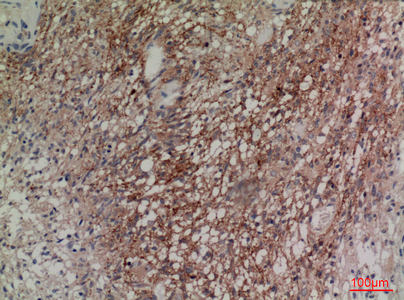Neuregulin-2 Polyclonal Antibody
- Catalog No.:YT5215
- Applications:WB;IHC;IF;ELISA
- Reactivity:Human;Mouse;Rat
- Target:
- Neuregulin-2
- Fields:
- >>EGFR tyrosine kinase inhibitor resistance;>>ErbB signaling pathway;>>Amyotrophic lateral sclerosis
- Gene Name:
- NRG2
- Protein Name:
- Pro-neuregulin-2 membrane-bound isoform
- Human Gene Id:
- 9542
- Human Swiss Prot No:
- O14511
- Mouse Swiss Prot No:
- P56974
- Rat Gene Id:
- 432361
- Rat Swiss Prot No:
- O35569
- Immunogen:
- The antiserum was produced against synthesized peptide derived from the Internal region of human NRG2. AA range:361-410
- Specificity:
- Neuregulin-2 Polyclonal Antibody detects endogenous levels of Neuregulin-2 protein.
- Formulation:
- Liquid in PBS containing 50% glycerol, 0.5% BSA and 0.02% sodium azide.
- Source:
- Polyclonal, Rabbit,IgG
- Dilution:
- WB 1:500 - 1:2000. IHC: 1:100-300 ELISA: 1:20000.. IF 1:50-200
- Purification:
- The antibody was affinity-purified from rabbit antiserum by affinity-chromatography using epitope-specific immunogen.
- Concentration:
- 1 mg/ml
- Storage Stability:
- -15°C to -25°C/1 year(Do not lower than -25°C)
- Other Name:
- NRG2;NTAK;Pro-neuregulin-2, membrane-bound isoform;Pro-NRG2
- Observed Band(KD):
- 90kD
- Background:
- This gene encodes a novel member of the neuregulin family of growth and differentiation factors. Through interaction with the ERBB family of receptors, this protein induces the growth and differentiation of epithelial, neuronal, glial, and other types of cells. The gene consists of 12 exons and the genomic structure is similar to that of neuregulin 1, another member of the neuregulin family of ligands. The products of these genes mediate distinct biological processes by acting at different sites in tissues and eliciting different biological responses in cells. This gene is located close to the region for demyelinating Charcot-Marie-Tooth disease locus, but is not responsible for this disease. Alternative transcript variants encoding distinct isoforms have been described. [provided by RefSeq, May 2010],
- Function:
- domain:ERBB receptor binding is elicited entirely by the EGF-like domain.,domain:The cytoplasmic domain may be involved in the regulation of trafficking and proteolytic processing. Regulation of the proteolytic processing involves initial intracellular domain dimerization.,function:Direct ligand for ERBB3 and ERBB4 tyrosine kinase receptors. Concomitantly recruits ERBB1 and ERBB2 coreceptors, resulting in ligand-stimulated tyrosine phosphorylation and activation of the ERBB receptors. May also promote the heterodimerization with the EGF receptor.,PTM:Extensive glycosylation precedes the proteolytic cleavage.,PTM:Proteolytic cleavage close to the plasma membrane on the external face leads to the release of the soluble growth factor form.,similarity:Belongs to the neuregulin family.,similarity:Contains 1 EGF-like domain.,similarity:Contains 1 Ig-like C2-type (immunoglobulin-like) domain.,s
- Subcellular Location:
- [Pro-neuregulin-2, membrane-bound isoform]: Cell membrane ; Single-pass type I membrane protein . Does not seem to be active. .; [Neuregulin-2]: Secreted .
- Expression:
- Restricted to the cerebellum in the adult.
- June 19-2018
- WESTERN IMMUNOBLOTTING PROTOCOL
- June 19-2018
- IMMUNOHISTOCHEMISTRY-PARAFFIN PROTOCOL
- June 19-2018
- IMMUNOFLUORESCENCE PROTOCOL
- September 08-2020
- FLOW-CYTOMEYRT-PROTOCOL
- May 20-2022
- Cell-Based ELISA│解您多样本WB检测之困扰
- July 13-2018
- CELL-BASED-ELISA-PROTOCOL-FOR-ACETYL-PROTEIN
- July 13-2018
- CELL-BASED-ELISA-PROTOCOL-FOR-PHOSPHO-PROTEIN
- July 13-2018
- Antibody-FAQs
- Products Images

- Western Blot analysis of HT29 cells using Neuregulin-2 Polyclonal Antibody. Secondary antibody(catalog#:RS0002) was diluted at 1:20000

- Immunohistochemical analysis of paraffin-embedded human-brain, antibody was diluted at 1:100

- Western blot analysis of lysate from HT29 cells, using NRG2 Antibody.



